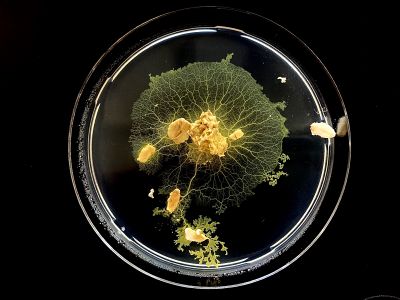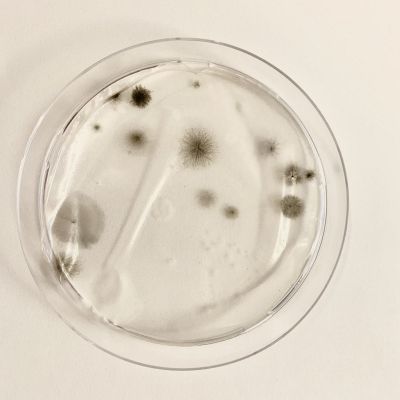- Physarum polycephalum
- What happened in the blank petri dish?
CONCEPT
By feeding physarum polycephalum, I found that many creatures are living by our side. They have different living habits from us, but they will live in their own way. They will have their own social circle and have completely different social rules. From the perspective of the universe, maybe we are also bacteria on the earth. So I want to know what bacteria are around me and what they look like.
INSPIRATION
This is the extra petri dish from the physarum polycephalum test. There are no objects placed in it except the agar base. After two weeks in the same environment as other physarum polycephalum, the magic is that different mold spots grow inside. I think it is very interesting. Many creatures live stubbornly in our unconsciousness. Judging from the appearance of mold, these should not be the same kind of bacteria. So I want to study what bacteria are around us and what these bacteria look like. I want to get acquainted with familiar strangers around us through this experiment.
PROJECT CONCEPT
The air that people inhale every day contains an average of around 50,000 microbial cells, most of which are imperceptible to the naked eye, but which are always with us. The variety of microorganisms varies from region to region, depending on the natural or human environment. For example, some places with more developed production and manufacturing industries may have more dust in the air; wet areas such as lakes and coasts may have more moulds. This is my second year living in Weimar and I want to find out the different microorganisms in the air of the city where I live. I want to collect the microorganisms in the air in different areas of Weimar and map them out so I can learn about some of the microorganisms around me. I plan to sample the microorganisms in the air in different areas around my school as an example. For example parks, streets, student dormitories, libraries etc.
GET SAMPLES
Plan 1
1. Use agar to establish a good culture environment in the Petri dishes.
2. Obtain microbial samples from different areas.
3. Leave the Petri dishes open for the same amount of time and bring them back sealed.
4. Observe the growth of the microorganisms.
5. See where there are the most microbial species.

Plan 2
1. Prepare the culture environment with agar in a Petri dish.
2. Choose different weather and bring the Petri dishes to the same area (choose an area according to plan 1).
3. Leave the Petri dishes open for the same amount of time and bring them back sealed.
4. Observe the growth of the microorganisms.

MAKE MAP
Plan 1
1. Place the container with the agar on the map and divide the different areas.
2. Cover the different areas separately.
3. When the corresponding position is reached, open the cover to allow contact with air.
4. Obtain samples from each of the different areas.

Plan 2
1. Cultivate each area of the microorganism in separate Petri dishes.
2. Select a section to cut.
3. Sew together with the other sections to form a map.

Plan 3
1. Grow the microorganisms in each area in separate Petri dishes.
2. After the microorganisms have grown, air dry the agar substrate.
3. Select a section to be cut.
4. Sew together with the other sections to form a map.

